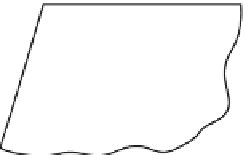Biomedical Engineering Reference
In-Depth Information
Fig. 3.7
Free edge of a bi-
material interface. For a bi-
material interface problem,
the order of the free edge
singularity depends upon the
insertion angles and the
material properties of the
adjoining materials
space is greatly simplified by Dundurs' [
22
] result that, for a body in plane stress or
plane strain loaded by prescribed tractions, the stress distribution depends on only
two dimensionless parameters:
a ¼
m
1
ðk
2
þ
1
Þm
2
ðk
1
þ
1
Þ
m
1
ðk
2
þ
1
Þþm
2
ðk
1
þ
1
Þ
b ¼
m
1
ðk
2
1
Þm
2
ðk
1
1
Þ
m
1
ðk
2
þ
1
Þþm
2
ðk
1
þ
1
Þ
where the subscripts 1 and 2 refer to bone and tendon, respectively;
m
i
¼ E
i
=
2
ð
1
þ n
i
Þ
,
and
k
i
¼
3
4
n
i
for plane strain. The parameter
a
can be understood in terms of a
dimensionless ratio of the reduced elasticmoduli of the twomaterials:
a ¼ðE
1
E
2
Þ=
ð E
1
þ E
2
Þ
,where
E
i
¼ E
i
=ð
1
n
2
i
Þ
for plane strain. For attachment of tendon to
bone, with bone corresponding to material 1,
a >
0. All materials must lie within
the range
1
a
1, and
a ¼
1 corresponds to a tendon attached to a perfectly
rigid bone.
b
also has a specific range of possible values, and these are
represented for the case of plane strain in Fig.
3.6
by the shaded region for all
materials with positive Poisson ratio. Tendon and bone lie in the hatched region
of the plot (elastic modulus for tendon ranging from 50 to 750 MPa; Poisson's
ratio for tendon ranging from 0.2 to 0.5; elastic modulus for bone ranging from
10 to 30 GPa; Poisson's ratio for bone ranging from 0.1 to 0.4).
For a “butt joint” in plane strain between tendon and bone, in which a rectangu-
lar tendon joins a rectangular bone as pictured in Fig.
3.7
(tendon and bone insertion
angles
y
1
¼ y
2
¼
90
), the characteristic equation analogous to that of (
3.9
) can be
found in Akisanya and Fleck [
20
] and can be rewritten in terms of the Dundurs
parameters:























Search WWH ::

Custom Search